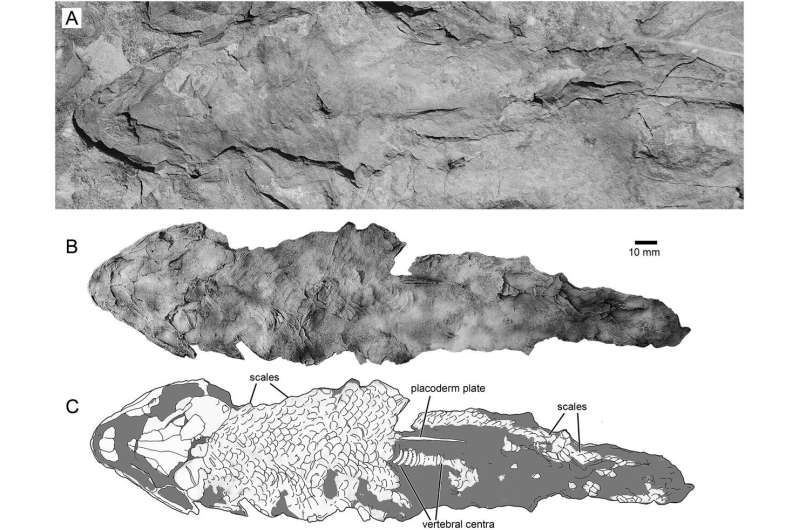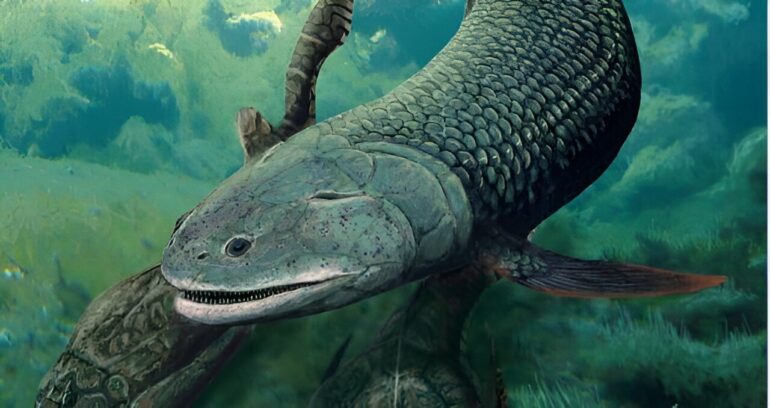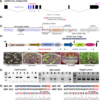Alice Spring’s Finke River (Larapinta), often cited as one of the oldest rivers in the world, once hosted waters teeming with bizarre animals—including a sleek predatory lobe-finned fish with large fangs and bony scales.
The newly described fossil fish has been named Harajicadectes zhumini by an international team of researchers led by Flinders University paleontologist Dr. Brian Choo.
The fossil was named for the Harajica Sandstone Member where the fossils were found in Australia’s “Red Center” and the ancient Greek dēktēs (“biter”). It also pays homage to Professor Min Zhu, currently at the Chinese Academy of Sciences, Beijing, who has made some major contributions to the research of early vertebrates.
One of the ancient Tetrapodomorph lineage, some of which became ancestors of limbed tetrapods—and later humans—Harajicadectes is particularly distinctive for its large openings on the top of their skull.
“These spiracular structures are thought to facilitate surface air-breathing, with modern-day African bichir fish having similar structures for taking in air at the water’s surface,” says Flinders Paleontology researcher Dr. Brian Choo, who studied the most complete specimen of the newly described Harajicadectes, which grew to about 40 cm.
“This feature appears in multiple Tetrapomodorph lineages at about the same time during the Middle-Late Devonian.
“In addition to Harajicadectes from central Australia, large spiracles also appeared in Gogonasus from Western Australia and elpistostegalians like Tiktaalik (the closest relatives to limbed tetrapods). Plus it also appears in the unrelated Pickeringius a ray-finned fish from Western Australia, first described in 2018.”

Harajicadectes zhumini from the Harajica Sandstone Member (Givetian–Frasnian), Northern Territory, Australia, Holotype NTM P6410. A, photographed as a natural mold in situ as it was discovered in 2016; B, as a whitened latex peel; and C, interpretative drawing. © Journal of Vertebrate Paleontology (2024). DOI: 10.1080/02724634.2023.2285000
Flinders Professor John Long, a leading Australian expert of fossil fish and co-author of the new discovery published in the Journal of Vertebrate Paleontology, says the synchronized appearance of this air-breathing adaptation may have coincided with a time of decreased atmospheric oxygen during the mid-Devonian.
“The ability to supplement gill respiration with aerial oxygen likely afforded an adaptive advantage,” says Professor Long. “We found this new form of lobe-finned fish in one of the most remote fossil sites in all of Australia, the Harajica Sandstone Member in the Northern Territory, almost 200 km west of Alice Springs, dating from the Middle-Late Devonian roughly 380 million years old.
“It is difficult to pinpoint where Harajicadectes sits in this group of fish as it appears to have convergently acquired a mosaic of specialized features characteristic of widely separate branches of the tetrapodomorph radiation.”
The publication is the culmination of 50 years of exploration and research.
ANU Professor Gavin Young first discovered fragmentary specimens in 1973 and many more fossils recovered in 1991 have been studied by the Melbourne Museum and Geosciences Australia in Canberra.
Attempts to study these fossils proved troublesome until the Flinders University’s 2016 expedition found an almost complete specimen.
“This fossil demonstrated that all the isolated bits and pieces collected over the years belonged to a single new type of ancient fish,” says Dr. Choo, from the College of Science and Engineering at Flinders.
The 2016 specimen has been transferred to the Museum and Art Galleries of the Northern Territory in Darwin.
More information:
Brian Choo et al, A new stem-tetrapod fish from the Middle–Late Devonian of central Australia, Journal of Vertebrate Paleontology (2024). DOI: 10.1080/02724634.2023.2285000
Provided by
Flinders University
Citation:
An ancient Australian air-breathing fish from 380 million years ago (2024, February 6)



